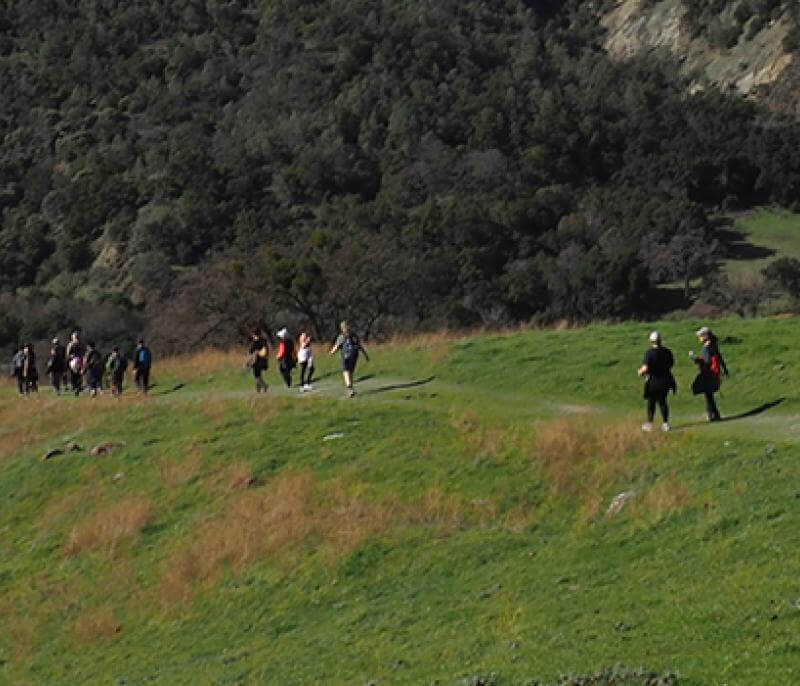Geocaching is an outdoor recreational activity where individuals, groups or families search for hidden containers known as geocaches. Handheld Global Positioning Units (GPS) are used to navigate to each geocache. The activity is initiated when a cache (normally a waterproof container with small items inside) is hidden, and its location is recorded with a GPS. A description of the cache and its GPS coordinates are then posted on a Geocaching website for others to view and find.
The District welcomes geocaching as a recreational activity in its parklands as long as it is practiced responsibly. Visitors are required to know and follow District Geocaching Guidelines to ensure a safe visit and to protect District natural and cultural resources.
District park units are varied and diverse. Geocaching is not appropriate for every park or area. Visitors are encouraged to become familiar with any specific geocaching rules associated with the particular park they are interested in.
General Guidelines
- A permit is not required for placing or searching for geocaches on District property.
- Geocache activity shall only take place during normal park hours (as defined in District Ordinance 38), and it is only allowed in areas that are open to the public.
- Caches must be registered on the Internet at the website www.geocaching.com.
- Caches shall comply with all guidelines established by the District and www.geocaching.com.
- Caches shall be clearly labeled with "Geocache" on the exterior. All caches must include a standard "stash note" inside, explaining the activity to an unintentional finder. Notes shall include the owner's contact information, including username and email address.
- Cache containers shall be of a "neutral" nature so as not to cause alarm or concern. Inappropriate containers include unmarked tubes, ammunition boxes that are not identified with clear "Geocache" markings, containers marked "biohazard" or "hazardous material" or any other suspicious looking containers.
- Caches shall be maintained by the person placing the cache. Caches that have been abandoned or not maintained will be considered as litter and removed by the District.
- The District reserves the right to remove any cache that has been determined to be inappropriate due to location or content, or has an adverse impact on wildlife, vegetation, park visitors, neighbors, or natural or cultural resources. In the event the District must remove a cache, the District may attempt, but is not required, to notify the owner of the cache.
Geocaching Guidelines
Geocache Placement Guidelines
- Caches shall not be placed in a way that causes the development of new "unofficial" trails.
- Caches shall not be placed in locations that cause trail damage or erosion.
- Caches may not be buried. Vegetation, rocks or other features may not be marked or damaged in the process of placing, accessing or maintaining the cache.
- Caches are not allowed within 100' of streams, lakes, marshes, wetlands, or any other sensitive water features.
- Caches shall not interfere with wildlife habitat, affect rare or special species of plants or animals, or interfere with other park visitors.
- Caches shall not be placed on or in buildings, structures, or facilities within a park.
- Caches shall not be placed within or near designated historic or cultural resource areas. Modification of archaeological or geographical features is prohibited.
- Altering District signs, fences, posts, trails, trail markers or any District building or facility is prohibited. Caches shall not be placed inside fenced areas.
- Caches shall not be placed on or near potentially hazardous locations.
- Caches shall not contain inappropriate, hazardous or illegal materials such as flammables, explosives, controlled substances, pornography or food. Contents shall be of a family-friendly nature and not be offensive.
District Parks and Areas Off Limits to Geocaching
|
Geocaching Frequently Asked Questions
What is geocaching?
Geocaching (geo-cashing) is an outdoor adventure activity that uses a handheld GPS (Global Positioning System) unit to find a hidden container (a cache). Individuals and groups set up caches all over the world and they share the coordinates on the internet. GPS units are used to find the location of a cache, sign the logbook, and then report the find on the internet.
Do I need a permit?
A permit is not necessary. It is important to read the guidelines to learn where geocaching is allowed and where it is prohibited.
Is there just one website for geocaching?
There are several websites, but the District works with www.geocaching.com
What do you do with a geocache?
You write in the log. Some caches have items in them. The general rule is that if you take something, you should leave something.
What should not be in a cache?
www.geocaching.com has a list of guidelines, but basically, explosives, weapons, drugs, alcohol, food and candy should not be in a cache.
What should a cache look like?
A cache placed in the East Bay Regional Park District must be labeled as a geocache and have a logbook in it.
Where are caches hidden?
Caches are hidden all around. The game is to use your GPS unit to get to the area and then use clues from the website to help you locate the actual cache.
Are there any places that are off limits to caches?
Caches must not be buried; if a shovel, trowel, or pointy object is needed to find it or place it, it is not appropriate; this includes buried electrical boxes, valve boxes, etc.
- Caches are not allowed in, on, or near any buildings, service yards, or restrooms.
- Caches should not be placed in holes in the ground or in hillsides. These may be the home of some critter that would not appreciate an intruder. Caches are not allowed in marshes, creeks, or within 100 feet of any body of water.
- Caches that deface property, whether natural or man-made will be archived.
- Caches will not be allowed in parks that have archaeological, cultural, or historical sites that could be damaged by extra foot traffic.
- Caches must not be hidden in close proximity to active railroad tracks. In general, use a distance of 150 ft. All local laws apply.
- Caches should not be near, on or under public structures deemed potential or possible targets for terrorist attacks. These may include but are not limited to highway bridges, dams, government buildings.
What happens to caches that are in one of these places?
They may be reported to the website to be archived or they may be removed.
(Approved by General Manager on September 12, 2011)What kind of things are in geocaches?
Caches come in many forms, but there should be a logbook. The logbook may contain information about the person who hid the cache and will contain notes from all those that have found the cache. Some caches are bigger and can contain a variety of things: maps, small toys, pictures, tools, games, etc. The container and its contents should be waterproof, to protect the contents.

